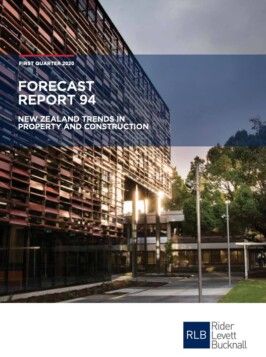The Rider Levett Bucknall (RLB) Forecast 94 report – New Zealand Trends in Property and Construction – released today confirms that Wellington led the way in non-residential construction growth over the past year, reflecting stronger demand for health and social buildings, as well as accommodation.
Prepared by the New Zealand Institute of Economic Research (Inc.) (NZIER) exclusively for Rider Levett Bucknall (RLB), Forecast 94 noted that although construction demand in Auckland remains strong, its share of total construction nationwide is starting to ease as construction demand in other regions picks up.
This includes increased construction demand in the other North Island regions, and South Island regions excluding Canterbury.
According to RLB Director, Grant Watkins, ‘Population growth has been particularly strong in Auckland, and these effects should continue to drive overall construction demand.’
‘However, the strong population growth has begun to spill over from Auckland to the other regions. We expect this internal migration will contribute to growth in construction becoming more broad-based across New Zealand,’ he said.
Auckland’s share of national construction starts to ease
With Auckland’s share of total construction in New Zealand easing, construction cost inflation in the region is also starting to moderate.
Non-residential construction cost increased sharply in the September 2019 quarter. We expect a moderation in construction cost inflation from these high levels over the coming year, given signs of easing capacity pressures in the construction sector.
RLB expects annual inflation will edge down to around 4% at the end of 2020, before moderating further to around 3% in the subsequent years.
The firm expects that, as construction activity continues to broaden beyond Auckland, capacity pressures in the construction sector in many other regions will increase. This should support a lift in construction cost inflation in these regions above that of Auckland’s.
Strong population growth and tourist inflows increase demand
According to RLB, stronger demand for accommodation was the main driver behind the increase in non-residential consent issuance, reflecting the effects of strong population growth and tourist inflows over the past year.
However, increased caution about business investment has seen some easing in consent issuance since mid-2019, particularly when it comes to the floor area of construction consented. Nonetheless, demand remains close to the levels seen in the previous building boom in 2008.
When it comes to construction cost pressures, there has also been some easing in the measure of value of consent issuance per square metre. This easing is in line with the moderation in construction cost inflation, as well as the recent weakening in the pricing environment reported by construction sector firms.
Building consents by sector
Grant continued, ‘According to RLB, hostels and hotels, as well as health facilities were the top three drivers of growth in non-residential construction consent issuance over the past year. The rebound in demand for health facilities reflected stronger demand in Auckland and Wellington.’
‘Demand for office buildings is also recovering, reflecting consent issuance for both new and alterations to office space. We expect earthquake strengthening activity will support further office consent issuance over the coming year,’ he added.
In contrast, there was a decline in consent issuance for farm buildings and retail outlets over the past year. Increased capital requirements have made banks more cautious about lending to the agriculture sector, and this will likely weigh on farm investment over the coming years.
Freshwater and Zero Carbon regulatory requirements also continue to present headwinds for farmers. In February, the government announced temporary restrictions on entry into New Zealand for all foreign nationals travelling from or transiting through mainland China in response to the Coronavirus.
The longer the outbreak persists, the greater the impact on our tourism and international education sector, which may have implications for non-residential construction demand in these areas.
Building consents by region
Although non-residential construction demand in Auckland has eased since mid-2019, it remains one of the key regions driving the growth in New Zealand non-residential construction over the past year. Demand in neighbouring region Waikato was also strong.
Wellington led the way in non-residential construction growth over the past year, reflecting stronger demand for health and social buildings, as well as accommodation.
In contrast, consent issuance in Canterbury fell sharply, driven by a decline in education buildings, office space and retail outlets.
RLB expects robust population growth will continue to drive non-residential construction demand in the main centres over the coming year.
FURTHER INFORMATION:



